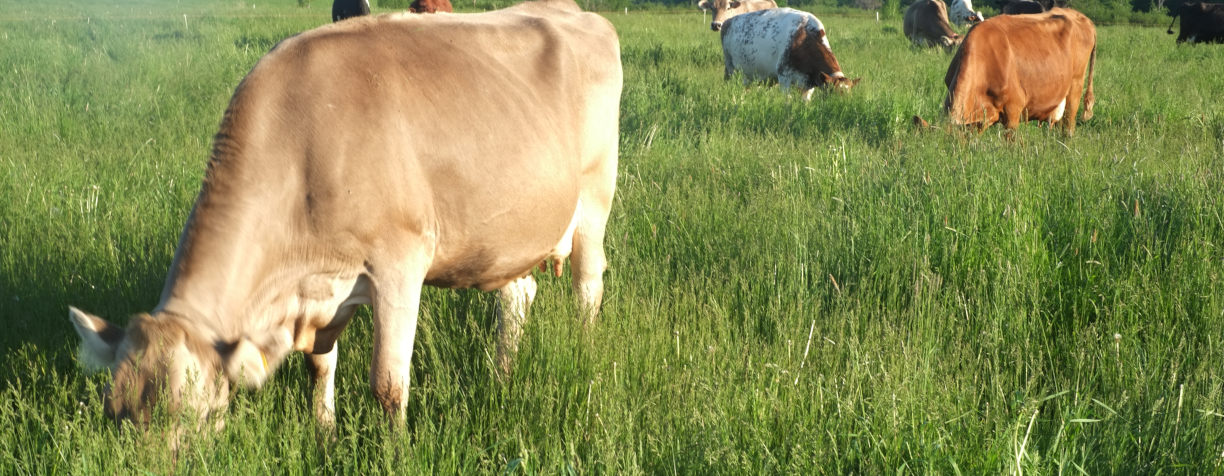Greg Galbraith
Agri-View
GILMAN, Wis. – Kevin Mahalko stopped his four-wheeler as he rode out to check his 40-cow milking herd of Holsteins grazing in a fresh paddock of grass. In the background were three flail chopper units that have long been retired from their duty of mowing fresh grass and clover, and bringing it to the cows in a feeder wagon.
“I always like to stop here and point this out to folks,” Mahalko said as he smiled and pointed to the flail choppers.
Beyond the flail choppers was the Mahalko Family Dairy Farm grazing operation. The flail choppers have been at rest since 1995; the farm is arranged with lanes and paddocks with long runs of temporary electric fence. The Mahalkos no longer bring fresh pasture to the cows; the cows feed themselves during the grazing season.
Mahalko studied biology when he first attended the University of Wisconsin-Stevens Point after high school but eventually changed his major to business administration and German. A year of study abroad reinforced his feelings about the importance of small farms.
His studies were in the land of German ancestors of the Mahalko family.
“Small farms are valued there,” he said. “The benefits trickle down to the local community and environment. My direct (ancestors) have always used grazing over multiple generations as far back as I know, including in Europe. Just not as intensively as modern rotational-grazing practices.”
He operates a grazing dairy farm near Gilman with his parents, Kenneth P. and Mary Mahalko. Kevin Mahalko does the bulk of the work involving milking and herd management while the farm is being transitioned to him. The Mahalko farm consists of 350 acres with 120 acres dedicated to rotational grazing. They have 130 acres of managed woodland with the balance in hay ground. The farm has been certified-organic since 2011; Mahalko currently markets his milk through Organic Valley Cooperative’s Grassmilk product line. Grassmilk is milk harvested from grass-fed cows without grain supplementation.
Mahalko is frank about his herd size of 40 cows.
“This model works well if you have an additional source of income,” he said.
Mahalko’s primary work since 2008 has been with River Country Resource Conservation and Development Council in conservation education. River Country partners with the Dairy Grazing Apprenticeship program; Mahalko is currently working to recruit new candidates to the program. He also held a job as a U.S. Postal Service carrier from 2014 to 2019.
He dedicates time to grazing advocacy; he has been the president of Grassworks, a grassroots organization that provides leadership and education to farmers and consumers for the advancement of managed grass-based agriculture.
Mary C. Anderson is the conservation and grazing Specialist with the Wisconsin Department of Natural Resource’s Bureau of Wildlife management. She has worked with Mahalko in a variety of capacities during the past 20 years.
“Kevin has spent many hours away from his grass-based organic dairy being a confident voice for grazing,” she said. “He has also opened up his farm for many educational events for farmers as well as nurses, students and scientists. He has traveled the country fighting for equal funding for grazing conservation practices, which don’t receive comparable funding to industrial-agricultural operations.”
Mahalko is scheduled to make a presentation in 2021 at the World Organic Conference in France provided the COVID-19 situation allows it.
Because Mahalko feeds no grain, pasture quality is of utmost importance.
“We shoot for a 40 percent legume content in our pastures,” he said.
He’s grazing purebred Holsteins. The herd is a result of years of artificial breeding that has resulted in a medium-sized Holstein with good feet and legs. His dad purchased the herd locally in 1980 and it has remained a closed herd since.
Through the years Mahalko’s pasture management has evolved toward taller pastures. He likes to graze them in the 12-inch to 18-inch range. He also implements a leader-follower-management grazing system where the milking herd moves quickly through paddocks, selecting the best grazing or “creaming the sward” as it’s referred to in grazing lingo. The heifers then follow to take the paddock height down further.
Mahalko calves his cows year-around. He uses a tiestall barn to house his cattle in the winter and fringe months when conditions are wet.
“We have pretty flat ground and I’m glad to have a place for the cows during the mud season,” he said. “Through the years of partnering with my dad and hiring some great relief milkers I’ve had the opportunity to work off the farm in roles that have ultimately benefited our farm. Now I am primarily at home due to COVID-19. I’m doing nearly all the milkings and enjoying with great appreciation the beautiful place, state and country I’m privileged to live in. The work hours are long but I’m doing something I genuinely love.
“I get to meet so many fascinating farmers, graziers, researchers, educators, leaders and politicians. My family and fiancée are involved with farming and are helping to move agriculture to new and higher levels through a spirit of cooperation because of the innovative farmers we work with.”
Greg Galbraith, a former dairy farmer who owns woodlot property in eastern Marathon County, Wisconsin, writes about the rapidly changing nature of the agricultural landscape. He has built a lifetime connection to the land and those who farm it.


